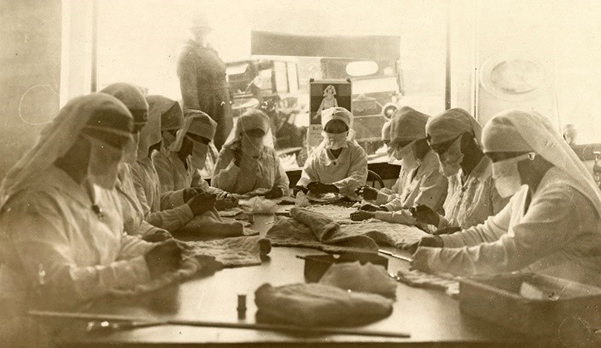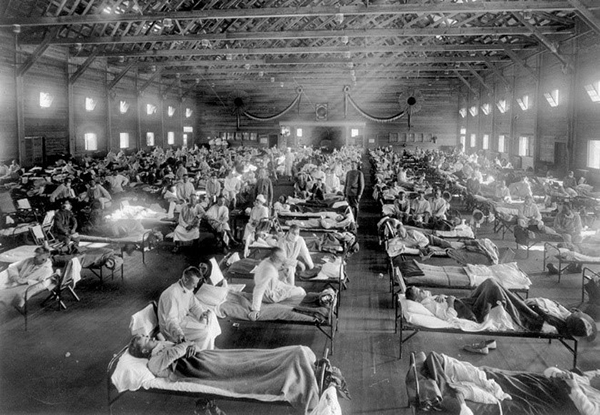Written by Stan Ingersol
From his column Past to Present

December 1918. (National Archive)
The coronavirus epidemic has several parallels to the Spanish influenza epidemic that ravaged the world between 1918 and 1920, burning out finally in autumn of its third year. By then, it had killed far more people than World War I.
Many people knew someone who had died.
Lois Carlisle, my grandmother, was sent with her sister away from the holiness community in Vilonia, Arkansas, in February 1920. They arrived at their grandparents’ home in Choctaw, Oklahoma, to learn immediately that their Uncle Sam, who as in the Army, had died of the Spanish flu. His body arrived a week later, but by then his brother Paul, age 7, was also dying from flu. Lois never forgot seeing the bodies of her two uncles lying side by side at the double funeral.1
Like today, public officials took different tacks in their response to the sickness. In Philadelphia, a grand victory parade was held Sept. 28, 1918, despite doctors’ concerns it would spread disease. Three days later, city hospitals were filled and 2,600 died within a week. But in St. Louis, the mayor imposed strict curfews just two days after the first case. The result? The death rate from Spanish flu in Philadelphia was over twice that of St. Louis.2
Whole communities were quarantined as the plague spread. Churches were not exempt. Most congregations willingly complied, but a few resisted. A leader in the Churches of Christ spoke for most Christians when he wrote he felt strongly that Christians needed to assemble, and yet, he argued, there are times when duty must yield to mercy.3
Nazarenes were affected like others. In the waning months of World War I, evangelists Bud Robinson and Milton Williams traveled with four musicians, conducting evangelistic meetings under a large tent. The flu “scourge” sidelined them.
Spanish flu took the life of Homer Goodell, superintendent of the Florida District.4 He was only 36.
A statewide quarantine postponed the Kentucky District Assembly, and General Superintendent John Goodwin postponed assemblies scheduled for the Arkansas and Dallas districts.
Spanish flu hit Nazarene Publishing House hard, leaving numerous employees sick. The Herald of Holiness noted that mail delivery was “especially uncertain,” a pertinent point to remind readers who regularly received the denomination’s weekly paper.
The epidemic struck Northwest Nazarene College in October 1918, infecting about 200 faculty and students. About 25 students were unaffected. Dr. Thomas Mangum, founder of the Nazarene Sanitarium in Nampa, advised healthy students on proper care for sick classmates. College and sanitarium also assisted the sick within the Nampa community.5
In north Texas, Peniel College’s encouraging prospects for high enrollment were shattered by the epidemic, which took the life of Miss Green, head of the speech department.6
General Superintendent R. T. Williams opened the 1918 Eastern Oklahoma District Assembly by immediately suggesting only essential business be conducted, noting that city officials might “close all public gatherings” soon. The delegates agreed.7

Ft. Riley, Kansas 1918. (National Archive)
In 1919, District Superintendent A. E. Sanner noted that the assembly year began with 10 district meetings scheduled on the Colorado District in fall and winter, but Spanish flu “defeated many of our plans.” All district churches were closed for three months and some for four. Aggressive evangelism campaigns began after bans lifted.8
The Committee on Deaconesses reported to the 1919 San Francisco District Assembly that the previous year had “called for heroic service. During the influenza epidemic, our Deaconesses did not shrink or falter but freely gave their services, counting not their lives dear unto themselves.”9 Deaconesses visited the sick and sat with the dying.
In 1919, the Chicago Central District reported that world war and Spanish influenza “left us an army of half a million” orphans. It urged the upcoming General Assembly “to do something worthwhile for the unfortunate, homeless children.”10 The Fifth General Assembly responded by creating the General Orphanage Board.
Eighteen years after the pandemic, Rev. C. P. Lanpher recalled the faithfulness of Nazarene who kept their pledges and paid their tithes during the plague, noting, “It was during the trying days of 1918 when the flu epidemic closed every church in the city . . . Half sick with the disease we clung to the pulpit one Sunday and preached from Malachi 3:10.” Pledge slips were distributed reading: “I will deposit one-tenth of my weekly earnings on the contribution plate of this church.”
The city shut down soon afterwards. Lanpher remembered, “Each Sunday morning, though there were no services in the house of God, our Nazarene treasurer made his way to each Nazarene home and found the storehouse tithe awaiting his coming.”11
Through plague and trial—sickness and quarantine—a writer urged readers of Herald of Holiness to keep “extra patient and extra sweet."12
Stan Ingersol is manager of archives for the Church of the Nazarene.
1Lois Niles, oral history, July 5, 2003. Conducted by Stan Ingersol and recorded by Chris Ingersol.
2Marisa Iallonardo, “How Two U.S. Cities Responded to the 1918 Flu Epidemic,” Business Insider (Apr. 1, 2020).
3John Mark Hicks, “How Churches of Christ Responded When the 1918 Spanish Flu Killed Millions,”
Christian Chronicle online, christianchronicle.org/how-churches-of-christ-responded-when-the-1918-spanish-flu-killed-millions (March 17, 2020).
4Herald for October 23, 1918
5J. Matthew Price, “We Teach Holiness: Life and Work of H. Orton Wiley,” Digital Edition (2006): 156.
6Journal of the Dallas District, 1918.
7Journal of the Eastern Oklahoma District, 1918:
8Report of the district superintendent, Journal of the Colorado District Assembly, 1919.
9Journal of the San Francisco District Assembly (1919).
10Journal of the Chicago District Assembly, 1919: 49.
11C. P. Lanpher, “Financing the Church,” The Preacher’s Magazine (March 1936): 32.
12Herald of Holiness (Oct. 30, 1918): 9.
